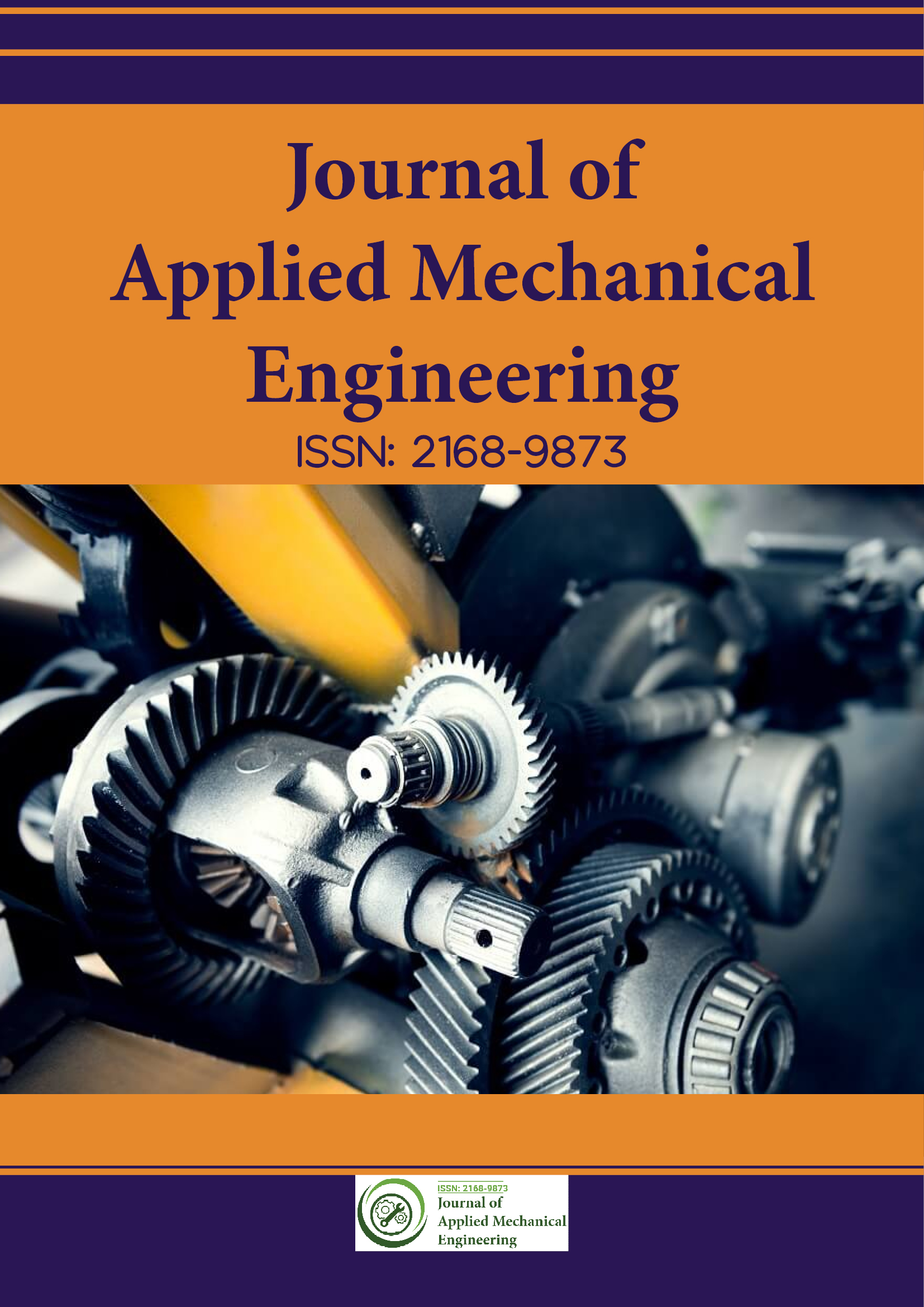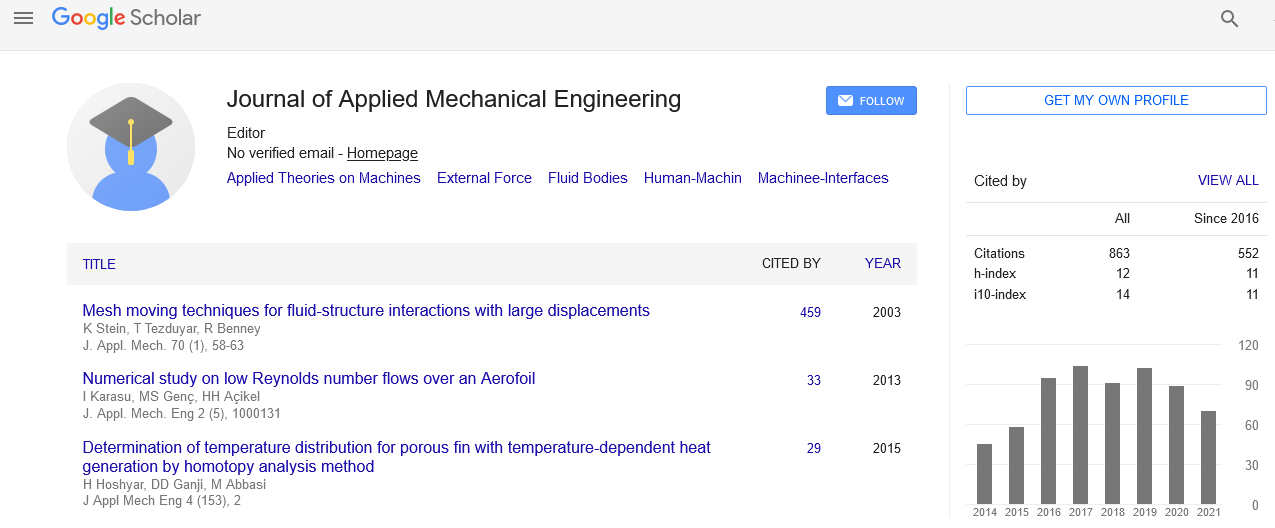Indexed In
- Genamics JournalSeek
- JournalTOCs
- CiteFactor
- RefSeek
- Hamdard University
- EBSCO A-Z
- OCLC- WorldCat
- Publons
- Google Scholar
Useful Links
Share This Page
Journal Flyer

Open Access Journals
- Agri and Aquaculture
- Biochemistry
- Bioinformatics & Systems Biology
- Business & Management
- Chemistry
- Clinical Sciences
- Engineering
- Food & Nutrition
- General Science
- Genetics & Molecular Biology
- Immunology & Microbiology
- Medical Sciences
- Neuroscience & Psychology
- Nursing & Health Care
- Pharmaceutical Sciences
Perspective - (2025) Volume 14, Issue 1
Prosthesis in Mechanical Engineering: Advancements in Restoring Functionality and Quality of Life
Brajesh Tewari*Received: 14-Nov-2023, Manuscript No. JAME-23-23908; Editor assigned: 17-Nov-2023, Pre QC No. JAME-23-23908 (PQ); Reviewed: 01-Dec-2023, QC No. JAME-23-23908; Revised: 03-Jan-2025, Manuscript No. JAME-23-23908 (R); Published: 13-Jan-2025, DOI: 10.35248/2168-9873.25.14.526
Descripition
Prosthetics, a remarkable field within mechanical engineering, focuses on the design and development of artificial limbs or prostheses to restore mobility and functionality to individuals who have experienced limb loss. As technology continues to advance, prosthetics have evolved from basic mechanical structures to sophisticated, sensor-driven devices that closely mimic natural movement. This article explores the principles, applications, challenges and future trends of prosthetics within the realm of mechanical engineering. Prosthesis is a customdesigned artificial limb created to replace a missing body part, typically a limb. Mechanical engineers play a crucial role in the development of prosthetics, combining principles of biomechanics, materials science and control systems to create devices that seamlessly integrate with the human body.
Biomechanics
Biomechanics forms the foundation of prosthetic design, involving the study of the mechanical aspects of living organisms. Engineers analyze the biomechanics of natural limbs to understand how joints, muscles and bones work together in harmony. This knowledge is then applied to replicate natural movement in prosthetic devices.
Materials science
The choice of materials is pivotal in prosthetic design. Engineers consider factors such as strength, flexibility and weight to ensure the prosthesis is durable and comfortable for the user. Advanced materials, including lightweight alloys and carbon fiber composites, contribute to the development of prosthetics that are both strong and lightweight.
Control systems
Prosthetic limbs often incorporate control systems that allow users to manipulate the device with natural movements. Myoelectric prostheses, for example, use sensors to detect muscle signals from the residual limb. These signals are then translated into specific movements of the prosthesis, providing a more intuitive and responsive user experience.
Applications of prosthesis in mechanical engineering
Lower limb prosthetics: Lower limb prosthetics are designed to replace missing legs or portions of legs. These devices can range from basic mechanical limbs to advanced computer-controlled prostheses. The goal is to provide users with a comfortable and functional replacement for natural limbs, allowing them to walk, run and engage in various activities.
Upper limb prosthetics: Upper limb prosthetics aim to restore functionality to individuals who have lost part or all of an arm. Advanced myoelectric prostheses enable users to control the movement of the prosthetic hand or arm by contracting specific muscles in the residual limb. This level of control facilitates tasks such as grasping objects and manipulating tools.
Bionic limbs: Bionic limbs represent a cutting-edge development in prosthetics, combining advanced materials with sophisticated control systems. These prostheses can provide a more natural and fluid range of motion, allowing users to perform intricate tasks with precision. Bionic limbs often incorporate sensors and feedback mechanisms to enhance the user's experience.
Osseointegration: Osseointegration involves surgically implanting a metal post into the bone, which serves as a direct attachment point for a prosthetic limb. This technique enhances the stability and functionality of the prosthesis, providing users with a more integrated and natural connection to the artificial limb.
Challenges and considerations
Achieving a comfortable and secure fit is a continual challenge in prosthetics. Engineers must design prosthetic sockets that distribute pressure evenly, preventing discomfort and potential skin issues for the user. Developing intuitive control interfaces for prosthetic limbs is crucial. Myoelectric control systems rely on precise muscle signals and optimizing the accuracy and responsiveness of these interfaces remains an ongoing challenge. The cost of advanced prosthetic devices can be a barrier for many individuals. Engineers and researchers are working towards developing cost-effective solutions without compromising on quality, making prosthetics more accessible to a broader range of users. Achieving seamless biomechanical integration between the prosthetic limb and the user's body is a complex task. Ensuring that the prosthesis moves naturally and in harmony with the user's movements requires a deep understanding of biomechanics and advanced control systems.
Conclusion
Prosthetics in mechanical engineering represent a remarkable fusion of technology, biomechanics, and materials science aimed at restoring mobility and improving the quality of life for individuals with limb loss. From basic mechanical limbs to advanced bionic prosthetics, the field continues to evolve, driven by a commitment to innovation and a deep understanding of human biomechanics. Challenges such as achieving a natural fit, enhancing user control and addressing cost barriers are actively being tackled by engineers and researchers. As technology advances, the future of prosthetics holds exciting possibilities, including direct neural interfaces, sensory feedback, and 3D-printed personalized solutions. Ultimately, the collaborative efforts of mechanical engineers, healthcare professionals and researchers in various fields contribute to the ongoing evolution of prosthetics, offering a beacon of hope and empowerment for individuals seeking to regain mobility and independence.
Citation: Tewari B (2025) Prosthesis in Mechanical Engineering: Advancements in Restoring Functionality and Quality of Life. J Appl Mech Eng. 14:526.
Copyright: © 2025 Tewari B. This is an open-access article distributed under the terms of the Creative Commons Attribution License, which permits unrestricted use, distribution, and reproduction in any medium, provided the original author and source are credited.

